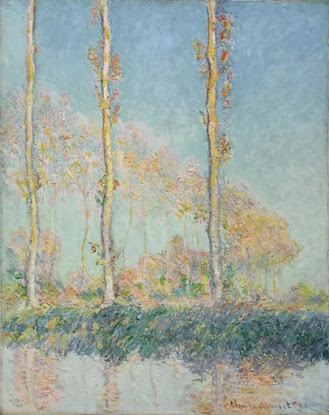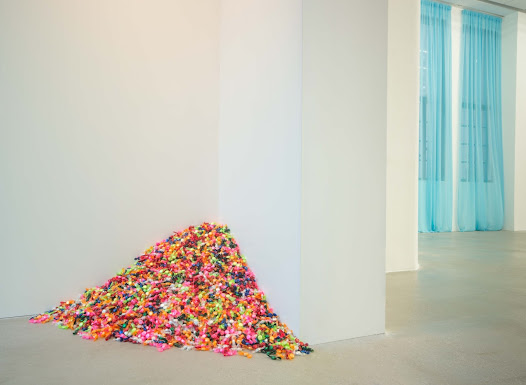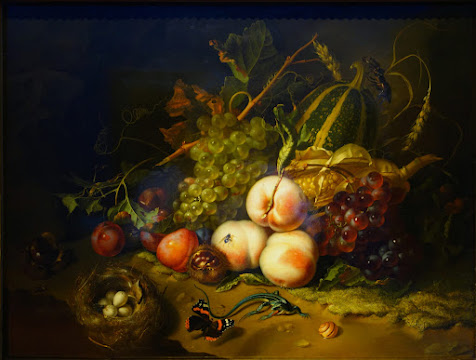Romantic Era Blog
Impressionism
The painting shown below is Poplars by Claude Monet. This work was done in 1891 with oil on canvas. The painting measures by 93x74.1 cm. It was painted in Giverny, France in the Epte River.
This work is beautiful. The colors Monet uses are stunning and it adds visual interest to the piece, as we are well aware poplar trees are not pink. But because of this color choice, it lends information to the viewer about this very specific frame of time the artist may have been painting it. We see through Monet's eyes at this momentary glance. The composition is quite engaging too. There are 3 trees off center to the left. My eye is drawn to the bottom right corner initially, and then dragged up across the 3 trees. I also think it is interesting because the number 3 has long been considered a symbol of luck and fortune. The quick and airy brushstrokes here are very evident of the impressionist art style.
The painting shown below is The Bellelli Family by Edgar Degas. This work was done in 1858-1867 with oil on canvas. It measures 200x250 cm.
Here, we also have an impressionist painting. Unlike the painting before, the painting style is not nearly as loose handed here. However, we do still get a softer look than other art styles. The painting has a very washed out, cool toned color scheme. These color choices make for a more solemn tone to the painting. This is a family portrait, but the mother seems to be the main focus by the way the composition is set up. The artist's choice to have the mother standing and dressed in all black with her black hair gives off an intense, strong feminine leadership. I also think her role as a nurturer to her two children is very obvious in the way she is in close contact with both. Whereas the father is set apart from both the mother and daughters.
While I find myself quite attracted to Monet's The Poplar, I am not as keen on The Bellelli Family. I believe a lot of this has to do with the color tones in both paintings. Monet uses a warm palette, whereas Degas is focused on cooler colors. I think this affects the viewers overall mood of the painting quite intensely. The subject matter obviously has a lot to do with personal preference as well. I believe Degas intention with this painting was to use the family portrait as a way to. I think Monet's work would look beautiful in a home or museum or just about anywhere, whereas Degas' subject matter is much more specific, and because of that I think it belongs solely to be viewed in a museum.
Pre-Raphaelite
The painting below is The Scapegoat by William Holman Hunt. This work was done in 1854-1856 with oil on canvas. It measures 86x140 cm. It was partly painted in Oosdomm in the Dead Sea.
My first impression was curiousity but simultaneous awe. The detail in this painting is jaw dropping. The background specifically is so beautiful. The purple of the mountains, with the variation of color in the sky and the reflection in the water. I suppose it comes with concern though. I think the landscape is gorgeous, but the goat is in obvious distress, and is clearly surrounded by death. I think the conflicting factors of this is why the image works so well. When I imagine death, it is never with a gorgeous skyline in the background. The red near the goats horns is supposed to be a beef filet. This is supposed to represent sins being washed away, as it was supposed to turn white when the sins were forgiven.
The painting below is Isabella by John Everett Millais. The work was done in 1848-1849 with oil on canvas. It measures 103x142.8 cm.
This immediately struck me as odd. Millais somehow managed to make the figures in the painting look both 2D and 3D at the same time. The three figures in front are so well detailed, with clear depth. However, behind them we see the faces of the people go flat. If I was told they were photoshopped in, I would believe it. The painting is very busy, I can imagine the sounds of the dinner table. The dog in the woman closest to us is staring out at the viewer. It almost looks alarmed or concerned.
The Scapegoat is an incredible piece of art. The detail is impeccable and I think the obvious contrast of life and death makes the painting emotionally evoking. The artist's intentions were very clearly about spreading the biblical message conveyed in the scripture his art was based off of. I do very much enjoy the painting, but that being said I am not sure it would be something I would enjoy owning, but I would love to view it at a museum. Isabella is a very interesting painting. Millais has quite a unique style of painting, but I'm not sure it is my cup of tea. Nevertheless, I think it would be a very pleasurable viewing experience in a museum.
Bibliography
Dr. Rebecca Jeffrey Easby, "A beginner’s guide to the Pre-Raphaelites," in Smarthistory, August 9, 2015, accessed March 26, 2024, https://smarthistory.org/a-beginners-guide-to-the-pre-raphaelites/.
Dr. Beth Harris and Dr. Steven Zucker, "Edgar Degas, The Bellelli Family," in Smarthistory, November 23, 2015, accessed March 26, 2024, https://smarthistory.org/edgar-degas-the-bellelli-family/.
Dr. Rebecca Jeffrey Easby, "William Holman Hunt, The Scapegoat," in Smarthistory, September 20, 2021, accessed March 26, 2024, https://smarthistory.org/william-holman-hunt-the-scapegoat/.
Dr. Steven Zucker and Dr. Beth Harris, "Claude Monet, Poplars," in Smarthistory, December 4, 2015, accessed March 26, 2024, https://smarthistory.org/claude-monet-poplars/.







Hi Lauren, you chose some really cool paintings. The Monet, like other Impressionist paintings, looks gentle and impermanent. This contrasts with the two pre-Raphaelite paintings in your blog, which have bold colors and sharp lines. I agree with what you said about the last painting in your blog. It is fascinating that the people look 2-D and 3-D at the same time. The movement and action in this painting still feels very real.
ReplyDeleteHi Lauren! Pre-Raphaelite style really caught my attention i would not think that this style would have existed during that time frame with 2-d and 3-d. While i love impressionism this is something different. I think that the artists from the Pre-Raphaelite were trying to express more emotions into paintings with a whole different style with realistic aspect to it! I love the way you discribed this style along with the impressionism since they are different styles completely opposite. Good job!
ReplyDelete